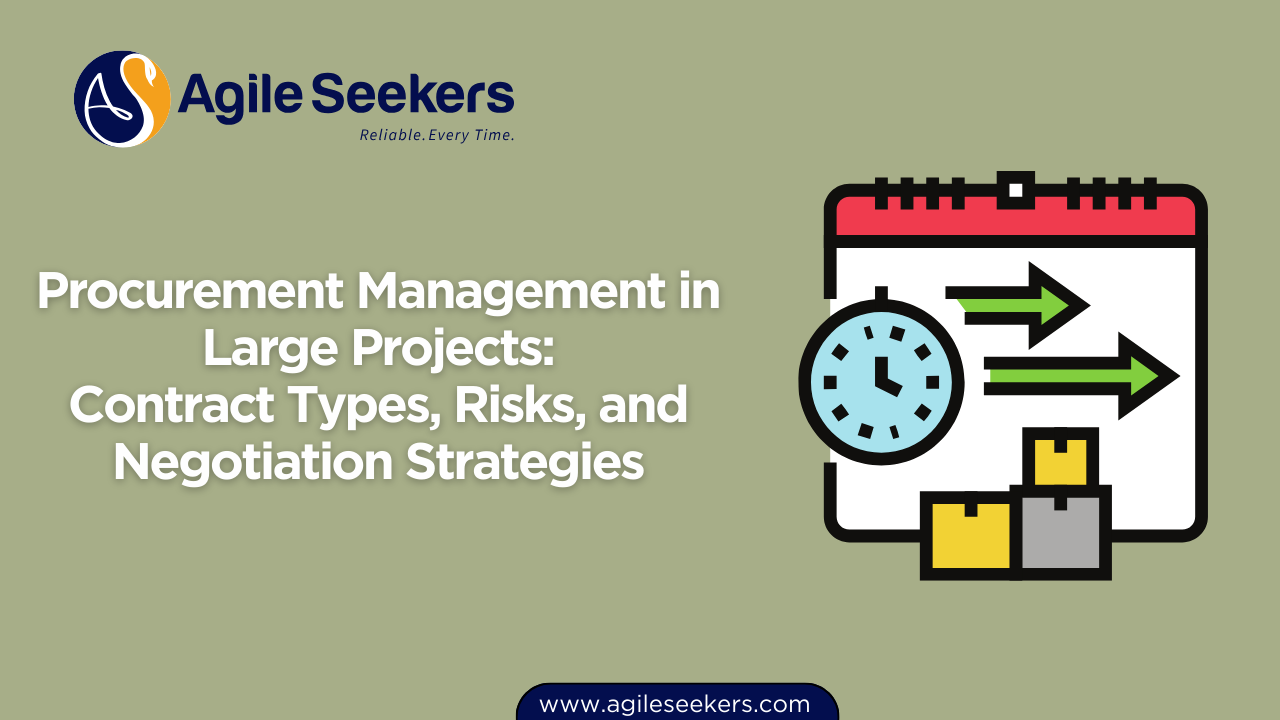Procurement Management in Large Projects: Contract Types, Risks, and Negotiation Strategies

Procurement management plays a vital role in large projects, often determining whether the project finishes on time, within budget, and to the expected quality. With multiple stakeholders, high-value contracts, and extended timelines, procurement in large projects is more complex and risk-laden than in smaller efforts. This post explores the key contract types used, common procurement risks, and the essential negotiation strategies every project manager should master.
Understanding Procurement in Large Projects
Procurement refers to the process of acquiring goods, services, or works from an external source. In large-scale projects, this process involves formal contracts, complex terms, and significant financial commitments. A solid procurement management plan helps ensure that vendors and contractors deliver what the project needs, when it needs it, under the right conditions.
The Project Management Professional certification recognizes procurement management as a core part of project success. Professionals pursuing PMP certification training learn how to structure procurement plans, select the right contract types, manage risks, and negotiate favorable outcomes.
Key Contract Types in Large Projects
Choosing the right contract type shapes the relationship between buyer and seller, defines risk distribution, and impacts the total project cost. Here are the primary contract types used in large projects:
| Contract Type | Key Features | Main Risks |
|---|---|---|
| Fixed-Price | Set price for defined scope; predictable costs | Seller bears cost overruns; potential for reduced quality |
| Cost-Reimbursable | Buyer reimburses costs plus fee; flexible scope | Buyer bears cost risk; requires detailed monitoring |
| Time & Materials (T&M) | Hourly/daily rates plus materials; adaptable for evolving needs | Costs can escalate; requires active oversight |
Fixed-price contracts work well when the project scope is clearly defined upfront. Cost-reimbursable agreements suit projects with uncertain requirements or innovative elements, while time and materials contracts are ideal for evolving scopes and short-term needs.
Procurement Risks in Large Projects
Large projects face several procurement-related risks that can derail delivery. Effective pmp training teaches project managers to anticipate and mitigate these risks.
- Scope Creep
Uncontrolled changes or continuous growth in project scope can lead to contract disputes, cost overruns, and delayed timelines. Clear requirements and rigorous change management processes help minimize this risk. - Vendor Nonperformance
Suppliers or contractors may fail to meet contractual obligations, whether due to financial instability, resource shortages, or skill gaps. Strong vendor selection, performance monitoring, and clear contract terms help safeguard project interests. - Price Escalation
Unexpected increases in material or labor costs can make fixed-price contracts unprofitable for sellers or push up the total project cost. Including escalation clauses in long-term contracts can provide a fair mechanism to adjust for inflation or market shifts. - Regulatory and Compliance Risks
Large projects, especially in industries like construction or defense, often face strict regulatory requirements. Contracts must incorporate compliance terms, and procurement teams need to ensure that vendors adhere to applicable laws and standards.
Negotiation Strategies and Risk Mitigation
Strong negotiation skills are essential for managing procurement effectively. Here’s a summary of negotiation strategies and how they connect to risk mitigation:
| Negotiation Strategy | Risk Mitigation Action |
|---|---|
| Understand both parties’ interests | Align contract terms to shared goals and minimize conflict |
| Define clear success criteria | Include measurable KPIs, SLAs, and milestones to ensure accountability |
| Use incentives and penalties | Motivate desired behaviors and discourage delays or nonperformance |
| Maintain flexibility | Allow controlled adjustments to scope or price without disruptions |
| Document everything | Maintain clear records to reduce ambiguity and support dispute resolution |
Integrating Procurement into the Project Plan
Procurement is not a standalone activity. It integrates closely with project planning, scheduling, risk management, and stakeholder engagement. The Project Management Professional certification emphasizes this integrated view, preparing professionals to align procurement activities with overall project goals.
For those looking to deepen their expertise, PMP certification training provides hands-on knowledge of procurement tools, techniques, and best practices. You can explore more about this at AgileSeekers PMP Certification Training.
Final Thoughts
Procurement management in large projects demands a careful balance of contract structuring, risk control, and negotiation mastery. By selecting the right contract type, anticipating procurement risks, and applying effective negotiation strategies, project managers can secure the goods and services their projects depend on — without unnecessary cost or conflict.
To strengthen your skills in procurement and overall project management, consider pursuing PMP certification or enrolling in dedicated pmp training. This credential equips you to handle complex procurement challenges and drive project success.
For more on procurement practices, you can explore the PMI Procurement Management Guide.
Also check - Earned Schedule Management: Extending EVA with Time-Based Metrics
Also check - Sensitivity Analysis for Project Risk Assessment




















